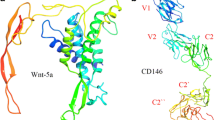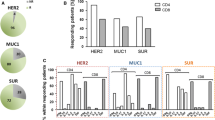Abstract
The dissemination of a malignant neoplasia is a complex process, which requires a set of molecules that remains unknown. It has been suggested that mucins and their carbohydrate-associated antigens may be implicated in tumour spreading which may be also influenced by an anti-MUC1 immune response. In this pilot study, we report the pattern of carbohydrate and peptidic MUC1-associated epitopes on carcinoma cells isolated from bone marrow (BM), taking into account primary tumour histopathologic features. We also bring information about the anti-MUC1 humoral response in these patients. Seventeen patients with invasive breast carcinoma were included. A sample of the primary tumour, a serum sample and a BM aspirate were obtained from each patient. Clinical features studied were tumour size, number of metastatic nodes, histological type and disease stage. Standard immunohistochemistry was performed with antigenic retrieval using different monoclonal antibodies (MAbs): anti carbohydrate antigens: Lewis x (KM380), sLewis x (KM93), Lewis y (C14) and Tn, anti-MUC1 peptide core MAbs: C595, HMFG2 and SM3, anti-cytokeratins, anti-protoncogenes ErbB2 and ErbB3 (IgG) MAbs and also anti-CD34 and anti-CD45 MAbs. ELISA techniques were employed to study circulating MUC1 as well as free and complexed anti-MUC1 antibodies. Immunohistochemical results showed that carbohydrate antigenic expression increases in BM neoplastic cells compared to the original tumours. However, we were not able to demonstrate that a humoral immune response to MUC1 has been induced in these patients. Finally, the employed procedures allow the selective immortalisation of micrometastatic carcinoma cells since short-term cell lines were established.
Similar content being viewed by others
References
Nicolson G. Tumor cell instability, diversification and progression to the metastatic phenotype: From oncogene to oncofetal expression. Cancer Res 1987; 47: 1473–87.
Putz E, Witter K, Offner S et al. Phenotypic characteristics of cell lines derived from disseminated cancer cells in bone marrow of patients with solid epithelial tumors: Establishment of working models for human micrometastases. Cancer Res 1999; 59: 241–8.
Brugger W, Bross KJ, Glatt M et al. Mobilization of tumor cells and hematopoietic progenitor cells into peripheral blood of patients with solid tumors. Blood, 1994; 83: 636–40.
Shpall EJ, Jones RB. Release of tumor cells from bone marrow. Blood, 1994; 83: 623–5.
Kirk SJ, Cooper GG, Hoper M et al. The prognostic significance of marrow micrometastases in women with early breast cancer. Eur J Surg Oncol 1990; 16: 481–5.
Salvadori B, Squicciami P, Rovini D et al. Use of monoclonal antibody Mbr 1 to detect micrometastases in bone marrow specimens of breast cancer patients. Eur J Cancer 1990; 26: 865–7.
Singletary SE, Larry L, Tucker SL et al. Detection of micrometastatic tumor cells in bone marrow of breast carcinoma patients. J Surg Oncol 1991; 47: 32–6.
Courtemanche DJ, Worth AJ, Coupland RW et al. Detection of micrometastases from primary breast cancer. Can J Surg 1991; 34: 15–9.
Wesseling J, van der Valk SW, Vos HL et al. Episialin (MUC1) overexpression inhibits integrin-mediated cell adhesion to extracellular matrix components. J Cell Biol 1995; 129: 255–65.
Kam JL, Regimbald LH, Hilgers JH et al. MUC1 synthetic peptide inhibition of intercellular adhesion molecule-1 and MUC1 binding requires six tandem repeats. Cancer Res 1998; 58: 5577–81
Regimbald LH, Pilarski LM, Longenecker BM et al. The breast mucin MUC1 as a novel adhesion ligand for endothelial intercellular adhesion molecule 1 in breast cancer. Cancer Res 1996; 56: 4244–9
Yamamoto M, Bharti A, Li Y et al. Interaction of the DF3/ MUC1 breast carcinoma-associated antigen and β-catenin in cell adhesion. J Biol Chem 1997; 272: 12492–4
Bresalier RS, Ho SB, Schoeppner HL, Kim YS et al. Enhanced of sialylation of mucin-associated carbohydrate structures in human colon cancer metastasis. Gastroenterology 1996; 110: 1354–67.
Price MR, Pugh JA, Hudecz F et al. C595-a monoclonal antibody against the protein core of human urinary epithelial mucin commonly expressed in breast carcinomas. Br J Cancer 1990; 61: 681–6.
Burchell J, Gendler S, Taylor-Papadimitriou J et al. Development and characterization of breast reactive monoclonal antibodies directed to the core protein of the human milk mucin. Cancer Res 1987; 47: 5476–82.
Taylor-Papadimitriou J, Peterson JA, Arklie J et al. Monoclonal antibodies to epithelium specific components of the milk fat globule membrane: production and reactions with cells in culture. Int J Cancer 1981; 28: 17–21.
Hanai N, Shitara K, Yoshida H et al. Generation of monoclonal antibodies against human lung squamous cell carcinoma and adenocarcinoma usingmice rendered tolerant to normal human lung. Cancer Res 1986; 46: 4438–3.
Brown A, Feizi T, Goot HC. A monoclonal antibody against human colonic adenoma recognizes a difucosylated type-2 blood group chains. BiosciRep 1983; 3: 163–9.
Renkonen J, Paavonen T, Renkonen R. Endotelial and epithelial expression of sialyl Lewis x and sialil Lewis in lesions of breast carcinoma. Int J Cancer 1997; 74: 296–300.
Gilewski T, Adluri S, Ragupathi G et al. Vaccination of high-risk breast cancer patients with mucin-1 (MUC1) keyhole limpet hemocyanin conjugate plus QS-21. Clin Cancer Res 2000; 6: 1693–701.
Croce MV, Isla-Larrain M, Price MR et al. Detection of circulating mammary mucin (MUC1) and MUC1 immune complexes (MUC1-CIC) in healthy women. Int J Biol Markers 2001; 16: 112–20.
Croce MV, Isla-Larrain M, Capafons A et al. Humoral immune response induced by the protein core of MUC1 mucin in pregnant and healthy women. Breast Cancer Res Treat 2001; 2044: 1–11.
Slamon DJ, Godolphin W, Jones LA et al. Studies of the HER-2/neu proto-oncogene in human breast and ovarian cancer. Science 1989; 244: 707–12.
Latza U, Niedobitek G, Schwarting R et al. Ber-EP4: New monoclonal antibody which distinguishes epithelia from mesothelia. J Clin Pathol 1990; 43: 213–9.
Diel U, Kaufmann M, Costa SD et al. Micrometastatic breast cells in bone marrow at primary surgery: Prognostic value in comparison with nodal status. J Natl Cancer Inst 1996; 88: 1652–64.
Mansi JL, Gogas H, Bliss JM et al. Outcome of primary-breast-cancer patients with micrometastases: A long term follow-up study. Lancet 1999; 354: 197–202.
Kruger A, Schirrmacher V, von Hoegen P. Scattered micrometastases visualized at the single cell level: Detection and re-isolation of lacZ-labeled metastasized lymphoma cells. Int J Cancer 2002; 58: 275–84.
Weihrauch M, Skibowski E, Koslowsky TC et al. Immunomagnetic enrichment and detection of micrometastases in colorectal cancer: Correlation with established clinical parameters. J Clin Oncol 2002, 20: 4338–43.
Janni W, Rjosk D, Braun S. Clinical relevance of occult metastatic cells in the bone marrow of patients with different stages of breast cancer. Clin Breast Cancer 2000; 1: 217–25.
Sikut R, Zhang K, Baeckstrom D et al. Distinct sub-populations of carcinoma-associated MUC1 mucins as detected by the monoclonal antibody 9H8 and antibodies against the sialyl-Lewis a and sialyl-Lewis x epitopes in the circulation of breast-cancer patients. Int J Cancer 1996; 66: 617–23.
Matsuura N, Narita T, Mitsuoka C et al. Increased level of circulating adhesion molecules in the sera of breast cancer patients with distant metastases. Jpn J Clin Oncol 1997; 27: 135–9.
Yamaguchi A, Ding K, Maehara M et al. Expression of nm23-H1 gene and Sialyl Lewis X antigen in breast cancer. Oncol 1998; 55: 357–62.
Hellström I, Garrigues HJ, Garrigues U et al. Highly tumor-reactive, internalizing, mouse monoclonal antibodies to Ley-related cell surface antigens. Cancer Res 1990; 502183–90
Pastan I, Lovelace ET, Gallo MG et al. Characterization of monoclonal antibodies B1 and B3 that react with mucinous adenocarcinomas. Cancer Res 1991; 51: 3781–7.
Steplewski Z, Lubeck MD, Scholz D et al. Tumor cell lysis and tumor growth inhibition by the isotype variants of MAb BR55-2 directed against Y oligosacharide. In Vivo 1991; 5: 79–832.
Croce MV, Colussi A, Price MR, Segal-Eiras A. Expression of tumour associated antigens in normal, benign and malignant human mammary epithelial tissue: a comparative study. Anticancer Res 1997; 17: 287–92.
Brooks SA, Leathem AJ. Expression of alpha-GalNAc glycoprotein by breast cancers. Br J Cancer 1995; 71: 1033–8.
Vredenburgh JJ, Simpson W, Memoli VA et al. Reactivity of anti-CD15 monoclonal antibody PM-81 with breast cancer and elimination of breast cancer cells from human bone marrow by PM-81 and immunomagnetic beads. Cancer Res 1991; 51: 2451–5.
Croce MV, Isla-Larrain M, Capafons et al. Antigens of peptidic and carbohydrate nature expressed by breast cancer tissues and malignant counterparts. Eur J Cancer 2002; S3: S56.
Brockhausen I, Yang JM, Burchell J et al. Mechanisms underlying aberrant glycosylation of MUC1 mucin in breast cancer cells. Eur J Biochem 1995; 233: 607–17.
Denda-Nagai K, Irimura T. MUC1 in carcinoma-host interactions. Glycoconj J 2000; 17: 649–58.
Gendler S. MUC1, the renaissance molecule. J Mammary Gland Biol Neoplasia 2001; 6: 339–53.
Barnd DL, Lan MS, Metzgar RS et al. Specific, major histocompatibility complex-unrestricted recognition of tumor-associated mucins by human cytotoxic T cells. Proc Natl Acad Sci USA 1989; 86: 7159–63.
Hayes DF, Silberstein SW, Rodrique SW et al. DF3 antigen, a human epithelial cell mucin inhibits adhesion of eosinophils to antibody-coated targets. J Immunol 1990; 145: 962–70.
Agrawal B, Krantz MJ, Reddish MA et al. Cancer-associated MUC1 mucin inhibits human T-cell proliferation, which is reversible by IL-2. Nat Med 1998; 4: 43–9.
Chan AK, Lockhart DC, von Bernstoff W et al. Soluble MUC1 secreted by human epithelial cancer cells mediates immune suppression by blocking T-cell activation. Int J Cancer 1999; 82: 721–6.
Lillehof EP, Han F, Kim KCh. Mutagenesis of a Gly-Ser cleavage site in MUC1 inhibits ectodomain shedding. Biochem Biophys Res Commun 2003; 307: 743–49.
von Mensdorff-Pouilly S, Verstraeten AA, Kenemans P et al. Survival in early breast cancer patients is favorably influenced by a natural humoral immune response to polymorphic epithelial mucin. J Clin Oncol 2000; 18: 574–83.
von Mensdorff-Pouilly S, Gouretvich MM, Kenemans P et al. Humoral immune response to polymorphic epithelial mucin (MUC1) in patients with benign and malignant breast tumors. Eur J Cancer 1996; 32A: 1325–31.
Croce MV, Isla-Larrain MT, Demichelis SO et al. Tissue and serum MUC1 mucin detection in breast cancer patients. Breast Cancer Res Treat, 2003; 81: 195–207
Kudryashov V, Glunz PW, Williams LJ et al. Toward optimised carbohydrate-based anti-cancer vaccines: Epitope clustering, carrier structure and adjuvant, all influences antibody responses to Lewis y conjugates in mice. Proc Natl Acad Sci USA 2001; 98: 3264–9.
Author information
Authors and Affiliations
Corresponding author
Rights and permissions
About this article
Cite this article
Croce, M., Isla-Larrain, M., Tur, R. et al. Antigenic differences between metastatic cells in bone marrow and primary tumours and the anti-MUC1 humoral immune response induced in breast cancer patients. Clin Exp Metastasis 21, 139–147 (2004). https://doi.org/10.1023/B:CLIN.0000024739.43297.ba
Issue Date:
DOI: https://doi.org/10.1023/B:CLIN.0000024739.43297.ba




